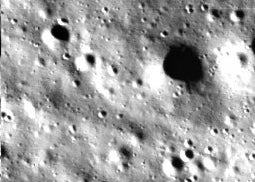Chandrayaan-3: India reveals first ever pictures taken near Moon’s uncharted south pole
Region could be key to future exploration of the Moon and the rest of the solar system – but it is notoriously difficult to land there

Your support helps us to tell the story
From reproductive rights to climate change to Big Tech, The Independent is on the ground when the story is developing. Whether it's investigating the financials of Elon Musk's pro-Trump PAC or producing our latest documentary, 'The A Word', which shines a light on the American women fighting for reproductive rights, we know how important it is to parse out the facts from the messaging.
At such a critical moment in US history, we need reporters on the ground. Your donation allows us to keep sending journalists to speak to both sides of the story.
The Independent is trusted by Americans across the entire political spectrum. And unlike many other quality news outlets, we choose not to lock Americans out of our reporting and analysis with paywalls. We believe quality journalism should be available to everyone, paid for by those who can afford it.
Your support makes all the difference.An Indian mission has sent back the first ever pictures taken near the Moon’s south pole.
The space agency’s Chandrayaan-3 mission became the first to land in the uncharted area when it made a successful soft landing on Wednesday. The region could be key to future missions because of its water ice, which could be used to fuel habitats on the Moon – but it is also especially difficult to land on, because of its rough terrain.
The first images show that rough terrain in precise detail. But they also show that the lander managed to land on a relatively flat region.
The Indian space agency shared the images soon after Chandrayaan-3 made its successful landing. Just before, it had also published images taken by the lander as it made its final descent onto the Moon, which show that rough surface – and can be seen to be getting bigger as the lander approaches the ground.
Earlier images, shown during the live feed of the descent, had included computer graphics of the landers arrival on the surface.
Shortly after, Indian space agency Isro announced that the rover had emerged from the lander and “took a walk on the Moon”, as it wrote on Twitter.

It will now spend two weeks surveying the lunar surface. ISRO chief S. Somanath said the “Pragyan” rover had two instruments to conduct element and chemical composition experiments.
“More than that it will do the roving on the surface, we will also do a robotic path planning exercise which is very important for us for future exploration,” Somanath told Indian news agency ANI.
Accomplished with a budget of about 6.15 billion rupees ($75 million), this was India’s second attempt to touch down on the moon. A previous mission in 2019, Chandrayaan-2, successfully deployed an orbiter but its lander crashed.
Chandrayaan means “moon vehicle” in Hindi and Sanskrit. Chandrayaan-3 is expected to remain functional for two weeks which equals one lunar day when its solar-powered equipment is built to last.
Additional reporting by agencies


